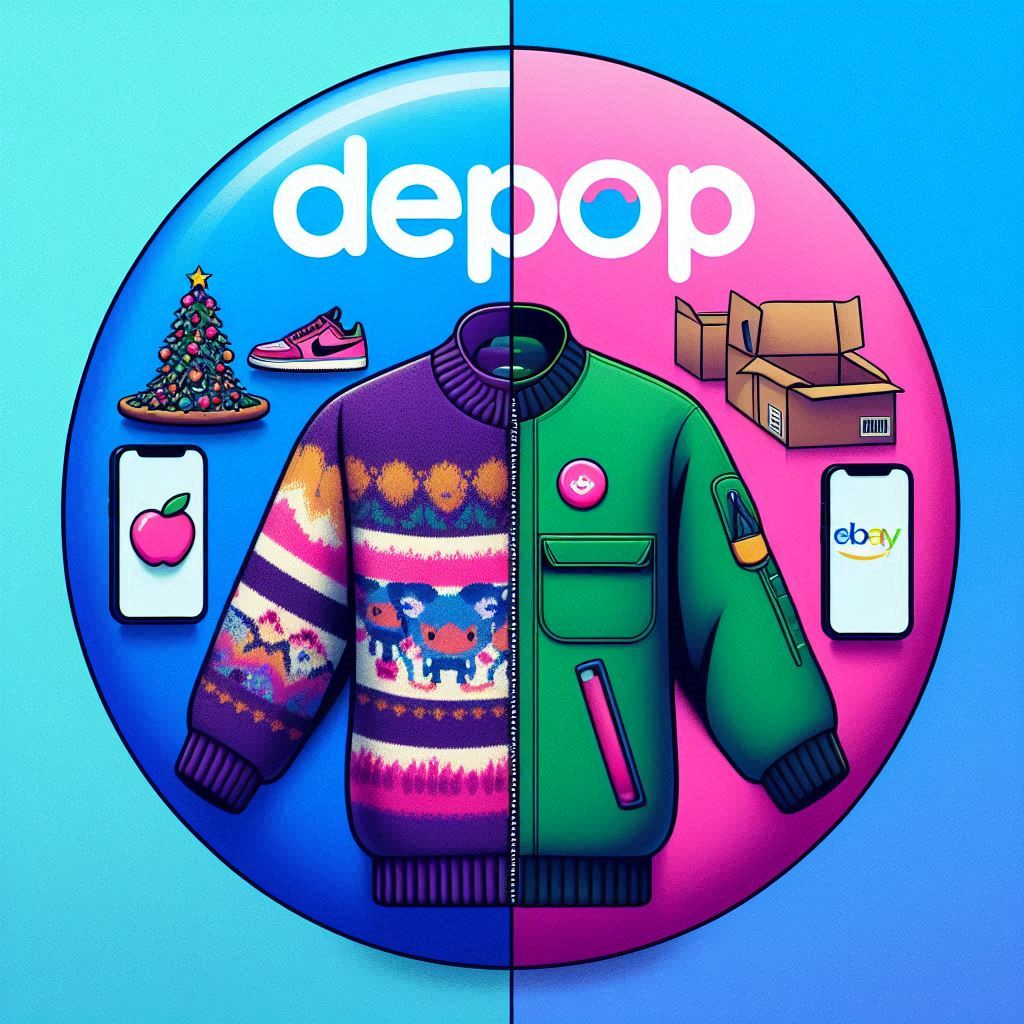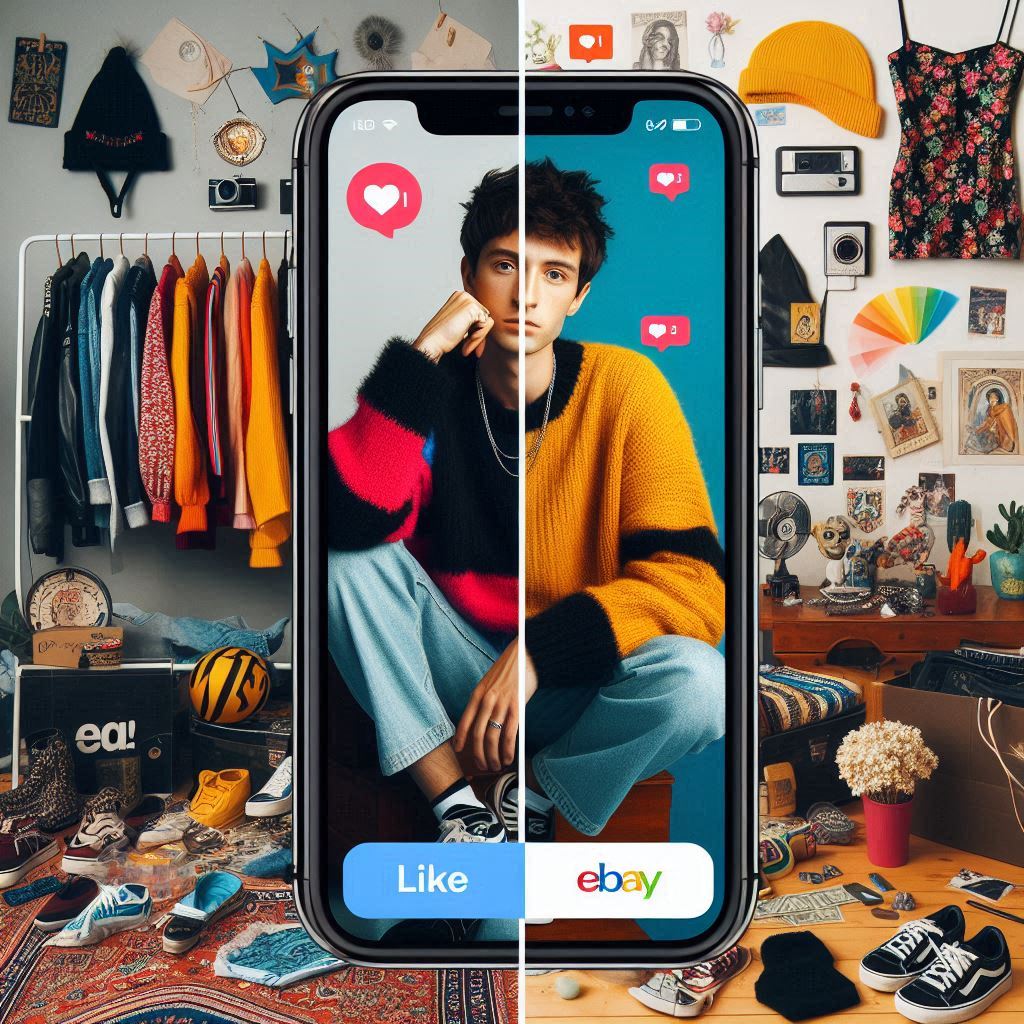Table of Contents
- Introduction
- Depop: The Fashion-Forward Social Marketplace
- eBay: The Ecommerce Giant
- Depop vs. eBay: Head-to-Head Comparison
- Choosing the Right Platform for You
- Additional Tips & Considerations
- FAQ
- Conclusion
Introduction
Remember that overflowing closet, packed with clothes you haven’t touched in years? It’s a common dilemma, and it often sparks the thought: “I could make some money off these!” Enter the world of online marketplaces, where platforms like eBay beckon with promises of turning pre-loved fashion into cash. eBay might be the first name that pops into your head, but navigating its vast landscape can be daunting, especially for new sellers. Don’t worry! This blog post is your guide to deciphering two popular platforms for selling clothes online: Depop and eBay. We’ll delve into their distinct pros and cons, helping you choose the perfect match for your selling style and goals.

Depop: The Fashion-Forward Social Marketplace
Imagine a virtual thrift store with a social media twist – that’s Depop! Think of it as a fusion of eBay and Instagram, where users can buy, sell, and connect over a shared passion for fashion.
What is Depop?
- A mobile-first social shopping app designed exclusively for buying and selling clothes and fashion accessories.
- Immensely popular with Gen Z and Millennials, attracting a younger, trend-conscious audience.
Pros of Depop:
- Free Listings: Listing your clothes on Depop is completely free. No need to worry about upfront costs or insertion fees!
- Strong Community: Depop fosters a vibrant sense of community. Social features like following, liking, and commenting encourage interaction and cultivate repeat customers.
- Targeted Audience: Depop’s focus on fashion attracts a specific demographic that’s actively seeking trendy, vintage, and unique pieces, making it a perfect platform for selling those statement items you no longer wear.
- Negotiation & Swapping: Depop embraces the art of the deal! It allows direct price negotiation between buyers and sellers, and even facilitates item swapping for a truly personalized shopping experience.
- Easy-to-Use App: The Depop app is incredibly user-friendly, making listing and managing your items a breeze.
- Responsive Customer Service: If you need assistance, Depop offers quick and efficient customer support to address your concerns.

Cons of Depop:
- High Competition: Depop’s popularity means you’ll face a higher level of competition from other sellers offering similar items. Strategic pricing and creative marketing become essential to stand out.
- Limited Pictures: Depop allows only four images per listing, potentially limiting your ability to showcase the details of your clothing.
- Direct Messaging Restrictions: You can’t send pictures directly through Depop’s messaging system. To share additional photos with buyers, you’ll need to utilize external social media platforms, which can be less convenient.
- Sophisticated Scammers: Like any online marketplace, Depop attracts its fair share of scammers. Exercise vigilance and prioritize completing transactions within the platform to benefit from its buyer/seller protection policies.
- Price Haggling: Depop’s culture of negotiation often leads to lower offers and bargain hunting. Be prepared for potential price haggling and set realistic pricing expectations.

eBay: The Ecommerce Giant
eBay is the veteran online marketplace – a true giant in the e-commerce world. It’s a sprawling platform where you can buy and sell a diverse array of items, from electronics to collectibles, and yes, even those clothes you’re looking to offload!
What is eBay?
- A longstanding online marketplace established in 1995, with a massive global user base spanning all demographics.
- Offers both fixed-price listings and the excitement of auction-style selling.
Pros of eBay:
- Vast Market: eBay’s reach is unparalleled! Listing your clothes on eBay grants you access to millions of potential buyers worldwide, significantly increasing your visibility and chances of making a sale.
- Diverse Demographics: eBay’s broad user base includes people from all age groups and interests. This diverse demographic makes it suitable for selling a wide range of clothing styles, including more classic and mature brands.
- Auction Feature: eBay’s auction format adds an element of excitement and can potentially drive up the prices of your items. If you have sought-after or rare clothing, an auction could lead to a higher profit.
- Money-Back Guarantee: eBay’s Money-Back Guarantee provides a layer of protection for buyers, encouraging them to make purchases with confidence. This program enhances buyer trust and can boost your sales.
- Sold Items Search: Gain valuable pricing insights by searching for previously sold items on eBay. This feature helps you understand market trends and price your clothes competitively.

Cons of eBay:
- High Fees: While eBay offers a limited number of free listings per month, you’ll encounter insertion fees for additional listings. Furthermore, eBay charges a final value fee on successful sales, which can impact your overall profit margins.
- Prevalence of Fakes: Despite eBay’s efforts to combat counterfeit items, fake or replica clothing remains a concern. Be vigilant when sourcing and listing items to avoid inadvertently selling counterfeit goods.
- Less Personal Interaction: eBay’s vastness can make it feel less personal and community-driven than Depop. Social features are more limited, and fostering a dedicated following can be more challenging.
- Dated Interface: eBay’s interface can feel somewhat dated, particularly on its mobile app. Navigation and listing management might be less intuitive compared to the streamlined Depop app.
- Customer Service Favors Buyers: While eBay does have a dedicated customer support system, their policies often prioritize buyer protection. As a seller, you might encounter situations where you feel less supported in resolving disputes.

Depop vs eBay: A Head-to-Head Comparison
We’ve explored the pros and cons of each platform, but a head-to-head comparison can offer further clarity. Let’s examine specific features side-by-side:
| Feature | Depop | eBay |
|---|---|---|
| Setup | Simple and quick account registration | Simple and quick account registration |
| Listing | Requires manual input for descriptions and hashtags | Offers auto-populated descriptions and price references |
| Selling | Allows price negotiation; might attract lower offers | Broader reach; potential for quick sales; auction feature |
| App | User-friendly and visually appealing | Offers in-depth analytics and the ability to send pictures within messages |
| Support | Highly responsive and efficient | Robust system; might prioritize buyer protection |
| Fees | Free listings; 10% commission on sales | Free listings up to a limit; insertion fees for additional listings; final value fees |
Choosing the Right Platform for You
The best platform for selling your clothes boils down to your individual preferences, selling style, and the type of clothing you want to sell.
When Depop is the Perfect Fit:
- Selling contemporary brands, trendy styles, vintage pieces, and unique finds.
- Targeting a younger, fashion-conscious audience.
- Comfortable with price negotiation and open to item swapping.
- Prefer a social shopping experience and value a strong sense of community.
- Seeking a platform with free listings and no upfront costs.
When eBay Might Be the Better Option:
- Selling a wide range of clothing, including classic brands and items appealing to a broader demographic.
- Looking to maximize reach and access a vast global audience.
- Interested in utilizing auctions to potentially increase selling prices.
- Prefer a more automated listing process with price references and auto-filled descriptions.

Additional Tips & Considerations
- High-Quality Photos: Whether you choose Depop or eBay, invest time in capturing appealing, well-lit photos of your clothing. Showcase details and highlight the condition of each item.
- Detailed Descriptions: Write clear and concise descriptions that accurately represent your clothing. Include relevant keywords to improve searchability.
- Exploring Alternatives: Don’t limit yourself to just Depop and eBay. Consider exploring other online marketplaces like Poshmark, Vinted, Etsy, and Facebook Marketplace to expand your reach and find the best platform for specific items.
FAQ
- Can I sell on both Depop and eBay? Absolutely! Using both platforms allows you to maximize your exposure and target different audiences.
- How can I protect myself from scams? Always complete transactions within the respective platforms, verify buyer/seller profiles, and be wary of unrealistic offers. If something seems too good to be true, it probably is!
- What brands are popular on Depop? Popular brands on Depop include Brandy Melville, Nike, I AM GIA, as well as vintage and Y2K styles.
- What if I have a dispute with a buyer? Contact the customer service of the platform where the transaction occurred. Follow their guidelines for dispute resolution.
Conclusion
Depop and eBay offer unique pathways to declutter your closet and earn money from your pre-loved clothes. Ultimately, the best platform depends on your selling preferences, target audience, and the type of clothing you’re looking to sell. Don’t hesitate to try both! Experimenting with different platforms can help you discover the perfect fit for your selling style.
Now, armed with this knowledge, it’s time to take action! Embrace the world of online marketplaces and start selling those clothes gathering dust in your closet.

